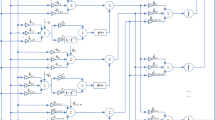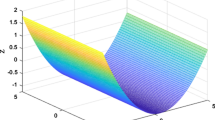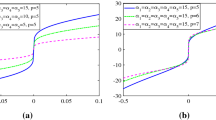Abstract
A typical class of recurrent neural networks called zeroing neural network (ZNN) has been considered as a powerful alternative for time-varying problems solving. In this paper, a new ZNN model is proposed and studied to solve the bound-constrained time-varying nonlinear equation (BCTVNE). Specifically, by introducing a time-varying nonnegative vector, the BCTVNE is reformulated as a combined system of nonlinear equations. On the basis of two indefinite error functions and the exponential decay formula, the new ZNN model is thus developed, which can zero in on the combined system. Theoretical analysis and simulation results are provided to verify the effectiveness of the proposed ZNN model. The applicability is further indicated under the simulations on an omnidirectional mobile robot manipulator via the proposed ZNN model.














Similar content being viewed by others
References
Mathews JH, Fink KD (2004) Numerical methods using MATLAB, 4th edn. Prentice Hall, Hoboken
Zhang Y, Yi C (2011) Zhang neural networks and neural-dynamic method. NOVA Science Publishers, New York
Zhang Y, Guo D (2015) Zhang functions and various models. Springer, Heidelberg
Chun C (2006) Construction of Newton-like iteration methods for solving nonlinear equations. Numer Math 104:297–315
Sharma JR (2005) A composite third order Newton-steffensen method for solving nonlinear equations. Appl Math Comput 169:242–246
Narang M, Bhatia S, Alshomrani AS, Kanwar V (2019) General efficient class of Steffensen type methods with memory for solving systems of nonlinear equations. J Comput Appl Math 35215:23–39
Liao Z, Gong W, Yan X, Wang L, Hu C (2020) Solving nonlinear equations system with dynamic repulsion-based evolutionary algorithms. IEEE Trans Syst Man Cybern Syst 50(4):1590–1601
Xiao L, Lu R (2015) Finite-time solution to nonlinear equation using recurrent neural dynamics with a specially-constructed activation function. Neurocomputing 151:246–251
Zhang Y, Zhang Y, Chen D, Xiao Z, Yan X (2017) From Davidenko method to Zhang dynamics for nonlinear equation systems solving. IEEE Trans Syst Man Cybern Syst 47(11):2817–2830
Zhang Y, Shi Y, Xiao L, Mu B (2012) Convergence and stability results of Zhang neural network solving systems of time-varying nonlinear equations. In: Proceedings of international conference on natural computation, pp 150–154
Jin L, Zhang Y, Li S, Zhang Y (2017) Noise-tolerant ZNN models for solving time-varying zero-finding problems: a control-theoretic approach. IEEE Trans Autom Control 62(2):992–997
Xiao L, Zhang Z, Li S (2019) Solving time-varying system of nonlinear equations by finite-time recurrent neural networks with application to motion tracking of robot manipulators. IEEE Trans Syst Man Cybern Syst 49(11):2210–2220
Li W, Xiao L, Liao B (2020) A finite-time convergent and noise-rejection recurrent neural network and its discretization for dynamic nonlinear equations solving. IEEE Trans Cybern 50(7):3195–3207
Zhang Y, Peng C, Li W, Shi Y, Ling Y (2012) Broyden-method aided discrete ZNN solving the systems of time-varying nonlinear equations. In: Proceedings of international conference on control engineering and communication technology, pp 492–495
Zhang Y, Qiu H, Peng C, Shi Y, Tan H (2015) Simply and effectively proved square characteristics of discrete-time ZD solving systems of time-varying nonlinear equations. In: Proceedings of IEEE international conference on information and automation, pp 1457–1462
Guo D, Xu F, Li Z, Nie Z, Shao H (2018) Design, verification and application of new discrete-time recurrent neural network for dynamic nonlinear equations solving. IEEE Trans Ind Inform 14(9):3936–3945
Zhang Y, Qi Z, Qiu B, Yang M, Xiao M (2019) Zeroing neural dynamics and models for various time-varying problems solving with ZLSF models as minimization-type and Euler-type special cases. IEEE Comput Intell Mag 14(3):52–60
Li S, Jin L, Mirza MA (2019) Kinematic control of redundant robot arms using neural networks. Wiley, Hoboken
Guo D, Li S, Stanimirovic PS (2020) Analysis and application of modified ZNN design with robustness against harmonic noise. IEEE Trans Ind Inform 16(7):4627–4638
Zhang Y, Li W, Liao B, Guo D, Peng C (2014) Analysis and verification of repetitive motion planning and feedback control for omnidirectional mobile manipulator robotic system. J Intell Robot Syst 75(3–4):393–411
Chen D, Zhang Y (2018) Robust zeroing neural-dynamics and its time-varying disturbances suppression model applied to mobile robot manipulators. IEEE Trans Neural Netw Learn Syst 29(9):4385–4397
Xiao L, Liao B, Li S, Zhang Z, Ding L, Jin L (2018) Design and analysis of FTZNN applied to the real-time solution of a nonstationary Lyapunov equation and tracking control of a wheeled mobile manipulator. IEEE Trans Ind Inform 14(1):98–105
Raja R, Dutta A, Dasgupt B (2019) Learning framework for inverse kinematics of a highly redundant mobile manipulator. Robot Auton Syst 120:103245
Bai G, Liu L, Meng Y, Luo W, Gu Q, Wang J (2019) Path tracking of wheeled mobile robots based on dynamic prediction model. IEEE Access 7:39690–39701
Khan AH, Li S, Chen D, Liao L (2020) Tracking control of redundant mobile manipulator: an RNN based metaheuristic approach. Neurocomputing 400:272–284
Xu F, Li Z, Nie Z, Shao H, Guo D (2019) New recurrent neural network for online solution of time-dependent underdetermined linear system with bound constraint. IEEE Trans Ind Inform 15(4):2167–2176
Li S, Chen S, Liu B (2013) Accelerating a recurrent neural network to finite-time convergence for solving time-varying Sylvester equation by using a sign-bi-power activation function. Neural Process Lett 37(2):189–205
Tocino A, Ardanuy R (2002) Runge–Kutta methods for numerical solution of stochastic differential equations. J Comput Appl Math 138(2):219–241
Iacus SM (2008) Simulation and inference for stochastic differential equations: with R examples. Springer, New York
Mirzaee F, Hamzeh A (2017) Stochastic operational matrix method for solving stochastic differential equation by a fractional brownian motion. Int J Appl Comput Math 3:411–425
Averina TA, Rybakov KA (2019) A modification of numerical methods for stochastic differential equations with first integrals. Numer Anal Appl 12:203–218
Contreras-Reyes JE, Quintero FOL, Wiff R (2018) Bayesian modeling of individual growth variability using back-calculation: application to pink cusk-eel (Genypterus blacodes) off Chile. Ecol Model 385:145–153
Acknowledgements
The authors would like to thank the editors and reviewers for the time and effort they spent reviewing this paper as well as for their detailed and constructive comments for the paper improvement in terms of presentation and quality.
Funding
This paper is supported by the Basic Scientific Research Project for University of Heilongjiang Province with Number being 135409611, and also the Quanzhou City Science and Technology Program of China with Number being 2018C111R.
Author information
Authors and Affiliations
Corresponding author
Ethics declarations
Conflict of interest
Z. Ma declares that he has no conflict of interest. S. Yu declares that he has no conflict of interest. Y. Han declares that he has no conflict of interest. D. Guo declares that he has no conflict of interest.
Ethical approval
This paper does not contain any studies with human participants or animals performed by any of the authors.
Additional information
Publisher's Note
Springer Nature remains neutral with regard to jurisdictional claims in published maps and institutional affiliations.
Rights and permissions
About this article
Cite this article
Ma, Z., Yu, S., Han, Y. et al. Zeroing neural network for bound-constrained time-varying nonlinear equation solving and its application to mobile robot manipulators. Neural Comput & Applic 33, 14231–14245 (2021). https://doi.org/10.1007/s00521-021-06068-6
Received:
Accepted:
Published:
Issue Date:
DOI: https://doi.org/10.1007/s00521-021-06068-6




